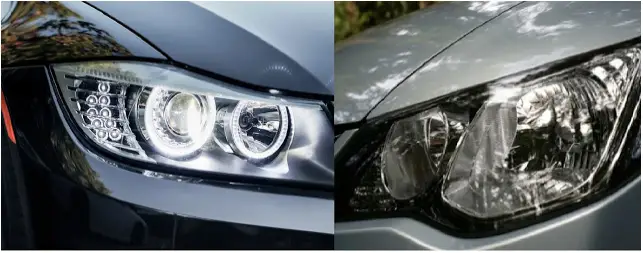
In the early days of motoring, reflector headlights have been used as standard equipment on automobiles ever since electrical lighting systems were invented. The basic mechanism consisted of an electric bulb inside a reflective metal bowl or a metal bowl fitted with reflective mirrors, sealed by a glass lens. The shape and intensity of the light beam was determined by the wattage of the bulb and the shape of the reflective mirrors.
The older reflector headlights were commonly known as the sealed-beam type. This kind of headlight had to be replaced as a whole unit in order to replace a burnt-out bulb. This was replaced in the 1980’s with plastic or metal housings or enclosures contaning mirrors to reflect the light beams into the road at the correct angle and allowed the owner of the vehicle to replace only the bulbs instead of the whole headlight. Tungsten bulbs were used at first but were soon replaced by halogen bulbs since they produced a much brighter and more intense light beam than regular tungsten-type bulbs.
Even up to now, the most basic and inexpensive cars, including commercial vehicles, use reflector headlamps since they are cheaper to make. One major disadvantage of reflector headlights using halogen bulbs is that efficiency is quite low compared to the modern projector lamps. The bulbs tend to get very hot, sometimes melting the plastic contacts and wires.
If your vehicle is fitted with reflector headlights using tungsten bulbs, and you intend to switch to halogen lighting, make sure to ask an experienced automotive electrician to install the new bulbs, as these require converting the connection using ceramic contacts and adding electrical relays as well. This will prevent the connectors and wires form melting and probably starting an electrical fire.
While projector headlights saw their first use in the late 1980s and early 1990s, they were only offered on the more expensive luxury sedans and sports cars. At the start of the new millenium, projector headlights have become more common, although not so much that reflector headlights have been replaced. Still, there might come a time when projector headlights might become the rule, as drivers become more and more demanding of the performance they can get out of their vehicles. It is also a matter of safety as projector headlights, while brighter, are built in such a way that they are not likely to blind the drivers of oncoming vehicles.
Mechanism-wise, projector headlights work the same as reflector headlights. The housing still contains a metal bowl with reflective mirrors, although in this case, the metal bowl is much deeper. Projector headlights also make use of a lens that acts as a magnifying glass. This increases the brightness of the light beam, which makes it easier for the driver to see where he’s going.
Projector headlights use Xenon high intensity discharge lamps which use around 35% to 40% less energy than halogen bulbs while producing a brighter light beam. Though the light beams from a projector headlight are more intense and direct, the angle of the bulbs do not blind the driver of oncoming vehicles. This is done through the use of a cutoff shield, which creates a distinct light barrier, which keeps the light from spreading out too much, blinding oncoming traffic. The cutoff shield is used or in place when the lights are in the low beam setting.
Unlike a reflector headlight’s high and low beams, which are controlled by electrical switches, a projector headlight’s high and low beams are controlled by a solenoid. When switching to high beam, the solenoid disengages and drops the cutoff shield out of the way. With the cutoff shield not blocking the light beam anymore, all the light that is produced by the bulb passes through, which gives full light output (high beam).
As we previously discussed in the article, not all vehicles are installed with projector headlights. The older your vehicle is, the more likely it will have reflector headlights. Conversely, the newer your car is, the more likely will it have projector headlights. The best way to find out what kind of headlight your vehicle has is to check the owner’s manual. Another way would be to ask your service advisor or an experienced mechanic about your car’s features and specifications. Still another way would be to check the internet for the information you are looking for.
Should your vehicle happen to have the older-style reflector headlights, and you want to convert them to projector headlights, it may be possible to do so, as long as there are aftermarket conversion kits available. You can ask the dealer where you purchased your car from about this, or you can ask a seasoned mechanic or car enthusiasts if they have attempted this conversion on their vehicles, especially if they have the same car as yours.
If it happens that conversion kits are not available, auxiliary projection lamps are available at automotive accessory stores. These are usually fitted under the bumper or integrated in your car’s front air dam. The store from which you buy them will usually have the brackets and other parts needed to fit the auxiliary lamps to your car, and most likely they will also have someone to install them for you. An important note, though: better check your state laws regarding aftermarket lighting as some states, such as California, have strict laws regulating the use of aftermarket lighting.
Of course, there is still the question to be answered: “Which are better, reflector or projector headlights?”
If your car is new, and it already comes fitted with projector headlights, the question is moot and academic. However, if your car comes with reflector headlights, there are still several factors you have to think about. How often do you drive at night? When you do drive at night, do you drive in the city, where there are well-lighted roadways, or in the country, where streetlights are few and far between? Do you find the lighting of reflector headlights lacking in illuminating the road in front of you, or can you see the road clearly? You may not really need to convert your vehicle’s lighting system, and you may be spending a large amount of money for something you might not need.
But ultimately, brighter is really better in terms of driving at night, and in the end, projector headlights are the ones that win the game.

Headlights are automotive jewelry. Correct fitment coupled with the right choice of technology will turn your vehicle into a shining gem.
Official sources of fitment information – https://sylvania-automotive.com and https://www.automotivebulbfinder.com/philips/